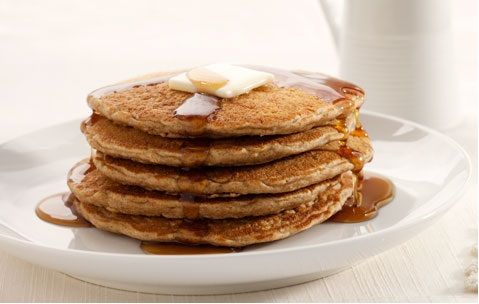Woe is me. Here I am in Los Angeles and try as I might, finding a really good pancake is just about the hardest thing to do! Why? I have no idea. That good ol’ American breakfast staple shouldn’t be so hard to do right, should it? Nevertheless, nearly everywhere I go from Abbot Kinney to Mid-Wilshire to Pasadena, I’ve yet to find that one pancake house that makes pancakes the way I like them and that’s—of medium thickness, nice flavor and without the Styrofoam texture that’s mostly what I find in chain restaurants and the mom n’ pops. Upon researching the subject, I came across a Serious Eats review written by Nick Solares who describes the best pancake better than I could ever do, saying it has, “A deeply bronzed, ever so slightly crisp exterior gives way to a fluffy, spongy, porous inner-core.” Sounds like poetry, huh? Edible poetry.
So what makes for that perfectly fluffy, crispy, non-hockey-puck-like pancake? I dare say it’s flour + fat + binding agent (eggs) + flavor cooked at the right temperature with the right oil. Alas, I’m remembering Feel Goods in Pasadena (they closed sometime in the 80s or 90s) and the Elk’s Lodge in Altadena which a friend used to drag me to when I was thirteen or so. The Elks made their pancakes with beer in the batter which I think they mixed in a huge old cask or drum. Their pancakes were the fluffiest I’ve ever had; divine even if eating them amidst mounted trophies of elk and moose freaked me out a bit. Feel Goods, another old Pasadena restaurant had those plastic gingham tablecloths and an atmosphere that transported you to the someplace in the South. Hot with lots of butter, their buttermilk pancakes had tang. Slathered in butter, when you went to slice them with your fork, it went right through the stack. Both places did pancakes the “right way.” Alas, I was too young to know how good I had it then.
In researching what makes the fluffiest, best tasting, well-cooked pancakes, here’s a summation of the few things I’ve learned:
Don’t Overbeat
Do not overbeat that batter! Whether you’re making them from scratch or from the box, your batter should have a few lumps in it. Do not use an electric beater, use a whisk or shake the ingredients together in a lidded Tupperware. America’s Test Kitchen recommends the “Well Method of Mixing” here.
Let the Batter Sit
Let the batter sit for five to ten minutes before you start making your pancakes. This lets the baking soda in the batter do more of its work. This is also a remedy for overly-beaten batters which should be set in the fridge and left to sit for 15-20 minutes. Some chefs recommend letting the batter sit overnight, fyi.
Heat the Pan with Oil then Wipe Down
The ideal temperature for pancake cooking is around 375 degrees (sprinkled droplets should sizzle then evaporate). If you’re using a skillet, heat your pan with a tablespoon of oil to medium high heat, then wipe it off with some paper towel. The oil should be near-smoking. Of course, you want to use an oil like canola, coconut, grapeseed, vegetable or corn. Butter can give a nice flavor but will scorch very fast, so proceed with caution. If you use butter, plan on wiping the pan down to remove the burnt butter. Using two pans will probably help you keep those cakes a’ comin.’
Do a Test Run
Plan on that first pancake or two being throw aways. You know the color you’re trying to achieve so adjust accordingly once you’ve got that first cake in the pan or on the griddle. In case you’re wondering, both the non-stick skillet and griddle seem to work equally well, so go with what you’re comfortable with.
Other Tips:
- The best mix—consensus amongst the chefs is none other than that cheap o’ Krusteaz, believe it or not. I’ve personally noticed Bisquick has a distinctive flavor that’s a bit too salty for my taste.
- Going for fluffy? Try beating your egg whites separately and folding them into the mix.
- The best flour—for traditional pancakes you want an All Purpose Flour that’s low in protein. Pillsbury and Gold Medal were the brands most mentioned. More tips from the chefs here.
- Opting for Buckwheat, Semolina or some other Grain? Good for you! You’ve got my vote. Plan on playing around with the amount of water and eggs you add since these grains behave very differently from AP flour. Why not do a test run the night before?
Just in case any one reading this is wondering about those beer pancakes I mentioned, I’ve found what works best are malty, lighter beers like Pabst Blue Ribbon or Coors Light. My own rendition of the beer pancake includes a very ripe banana which I pulverize then add to my barely beaten mix. I then take a perfectly ripe banana, cut up into triangular pieces, and add that into the batter. Banana and beer complement each other wonderfully. If you don’t like hops, you probably won’t like these pancakes btw. The beer really does add to the fluffiness. Next time I’m going to try the beer and the egg white method together to see just how fluffy I can get those pancakes! All I need is great maple syrup and a pot of coffee and we’re on! I don’t have an exact recipe but here’s one I’ve found.
Happy eating!
Now we’re proud to be on blogarama.com!





